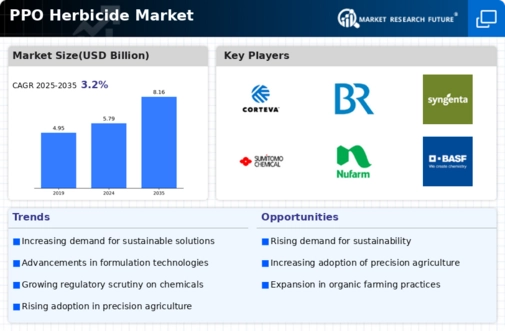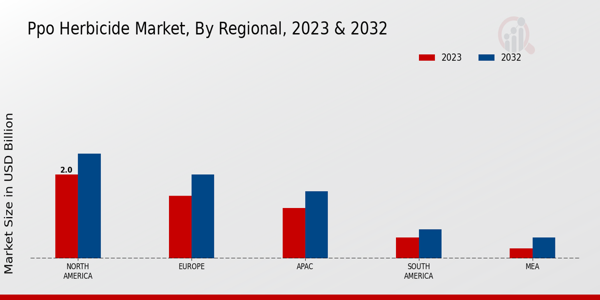Market Growth Projections
The Global PPO Herbicide Market Industry is projected to experience substantial growth over the next decade. With an expected market value of 5.79 USD Billion in 2024, the industry is on a path to reach 8.16 USD Billion by 2035. This growth is indicative of the increasing reliance on herbicides in modern agriculture, driven by technological advancements and changing consumer preferences. The compound annual growth rate (CAGR) of 3.17% from 2025 to 2035 further emphasizes the market's potential for expansion. These projections highlight the importance of continued innovation and adaptation in the herbicide sector.
Expansion of Crop Cultivation Areas
The expansion of crop cultivation areas globally is a key driver for the Global PPO Herbicide Market Industry. As agricultural land is increasingly utilized for food production to meet the demands of a growing population, the need for effective weed management solutions becomes critical. PPO herbicides offer effective control over a wide range of weeds, making them a preferred choice among farmers. This trend is expected to propel the market, with projections indicating a growth to 8.16 USD Billion by 2035. The increasing acreage dedicated to crops necessitates reliable herbicide options, further solidifying the market's trajectory.
Regulatory Support for Herbicide Use
Regulatory frameworks that support the use of herbicides are playing a crucial role in shaping the Global PPO Herbicide Market Industry. Governments worldwide are implementing policies that promote the safe and effective use of herbicides, which facilitates their adoption among farmers. This regulatory support is essential for ensuring that herbicides, including PPO types, are used responsibly while maximizing agricultural productivity. As the market evolves, these regulations are likely to adapt, further encouraging the use of PPO herbicides. The anticipated growth in the market underscores the importance of such supportive policies in fostering agricultural innovation.
Rising Demand for Sustainable Agriculture
The Global PPO Herbicide Market Industry is experiencing an upward trend due to the increasing demand for sustainable agricultural practices. Farmers are increasingly seeking herbicides that minimize environmental impact while maintaining crop yields. This shift is driven by consumer preferences for organic and sustainably sourced products. As a result, the market for PPO herbicides, which are known for their effectiveness and lower toxicity, is projected to grow. By 2024, the market is expected to reach 5.79 USD Billion, reflecting a growing commitment to sustainable farming practices globally.
Increasing Awareness of Weed Resistance Management
The growing awareness of weed resistance management is significantly impacting the Global PPO Herbicide Market Industry. Farmers are becoming increasingly cognizant of the challenges posed by herbicide-resistant weed populations, prompting them to adopt integrated weed management strategies. PPO herbicides are often included in these strategies due to their unique modes of action, which can help mitigate resistance development. This awareness is likely to drive demand for PPO herbicides, as farmers seek effective solutions to maintain crop health and yield. The market's growth trajectory reflects this shift towards more informed and strategic herbicide use.
Technological Advancements in Herbicide Formulation
Innovations in herbicide formulation are significantly influencing the Global PPO Herbicide Market Industry. Advances in chemical engineering and biotechnology have led to the development of more effective and targeted PPO herbicides. These innovations not only enhance weed control but also reduce the risk of crop damage. As a result, farmers are increasingly adopting these advanced formulations, which are expected to contribute to market growth. The anticipated compound annual growth rate (CAGR) of 3.17% from 2025 to 2035 indicates a robust future for the industry, driven by ongoing research and development efforts.

















